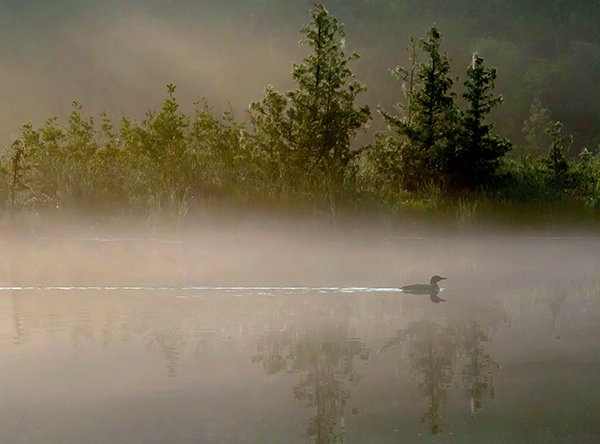
We are very honored to be able to interview Steve Jessmore, the winner of both first prize and honorable mention in the professional division of the 2021 Audubon Photography Awards. A veteran of professional photojournalism for major newspapers in the State of Michigan, shooting photos of his community in order to tell stories is his forte. Recently he has mastered action photography of birds to reveal their beauty, allowing him to reach the crescendo of his photography career. From people’s portraits, “Sense of Community”, to wildlife photography, Steve has demonstrated remarkable skill and sensitivity in subject matter and aesthetic presentation.
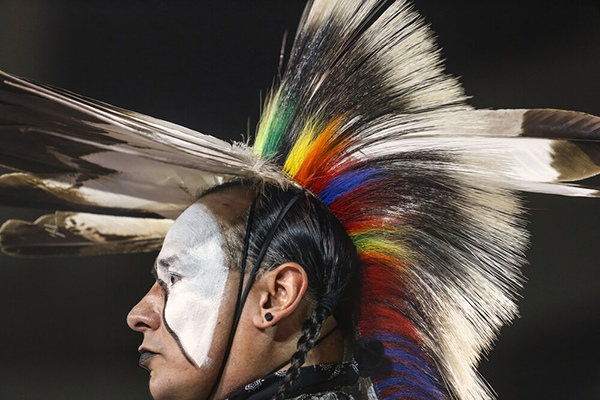
When Covid-19 arrived last year, Steve saw many things turn upside down. However, it also opened new avenues for him to venture out into nature to take photos of birds. Steve started to photograph birds near his house. He incorporated his previous photojournalistic training and it did not take long before he produced mesmerizing images. His new hobby later won him prestigious awards.
Below is Steve’s candid response to our questions. We hope you get to know how Steve has become such an outstanding photographer.
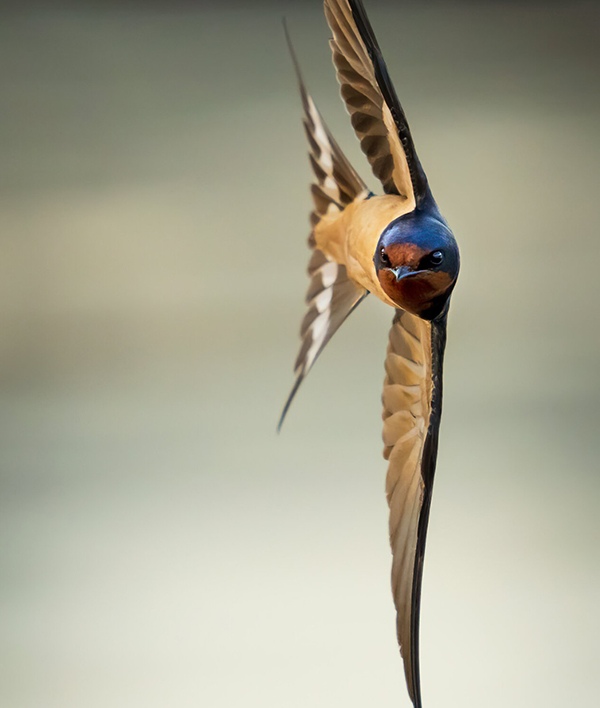
Q: Congratulations on winning both first prize and honorable mention in the professional division of the 2021 Audubon Photography Awards. Please tell us about the path you took that led you to be such an outstanding photographer.
A: I’ve always had a camera in my hands for as long as I can remember. My father owned a camera store and when I was young, he did environmental filmmaking on the side. I remember him making trips to the Everglades in Florida, working with others to bring awareness of the encroachment and damage civilization was doing to the area.
I started early using the camera as a way to make a living. I wanted to go to concerts when I was in high school in the mid-1970s but my parents said they cost too much. I remember asking them if I could find a way to go for free if that was ok. They laughed and said sure. At 16, I approached our local newspaper with a pitch and some concert photos I’d made. I told them I could do the job for them. We had no cell phones, but I gave them my home phone, my dad’s phone, my school office phone and told them to let me know if I could help. One day I got called to the school office and they offered me a concert to shoot – Parliament, and that was the first of more than 100 bands I photographed before graduating high school.
In college, I went into a fast-track pre-medicine program. The second semester I took a photojournalism class as an elective. I was hooked and I found enjoyment in being creative and telling stories instead of learning math and science. I followed a Journalism path with a biology minor. I found I loved to photograph people and tell their stories. I worked as a photojournalist for 30-years for newspapers The Saginaw News (my hometown in Michigan), the Flint Journal, and The Sun News in Myrtle Beach, SC. In 2013 I was recruited to be the photographer for Central Michigan University in Mount Pleasant, MI. In 2018 I quit my job and remarried, moving to the Grand Rapids, MI area. My wife Brenda works in the area and has three married daughters and grandchildren that lived there too. My children are grown and live in Brooklyn, NY; Peoria, IL, and Omaha, NE. It made sense for us to be there. I began freelancing and I shoot mainly editorial work and for universities.
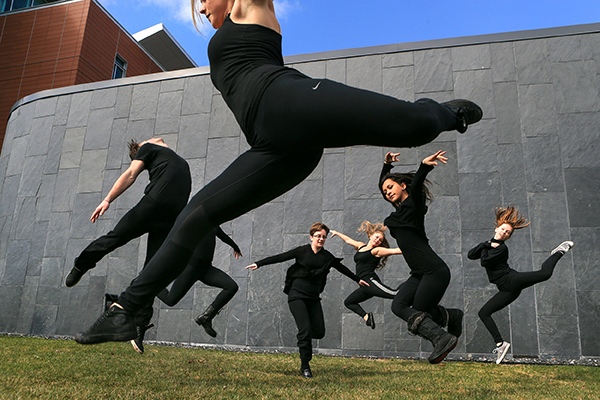
My freelance business client list grew quickly, and I had been busy. On March 8, 2020, my phone rang off the hook and my work for the year was mostly canceled or put on hold because of Covid. Many of us were in that same situation. I wasn’t sure what I would do, but finally thought I’d use whatever time to maybe learn how to light better or improve my work processes.
A month or so into Covid the lack of work was getting to me. My wife Brenda lifted me up and told me that every day is a gift from God. We need to make the best of it. You never know if it could be your last. This Covid, while devastating for many, was a gift of time. I needed to do what I’d always wanted to do. My problem – I didn’t know what that was.
It took me some time to figure that out. I did projects around the house and continued to think about it while isolating. In July I had an assignment to photograph kayaking and I tried one out for the first time. I ended up buying a kayak in July and taking my cameras out onto the Torch River at our northern Michigan cottage. It gave me great access to a new world.
The one thing I found captivating and frustrating was making bird photos. They were erratic, unpredictable, and very fast. There also wasn’t much light early and late in the day. I was hooked and this became my obsession. My purpose in life at that point was to solve this problem and “birds doing something” was my focus.
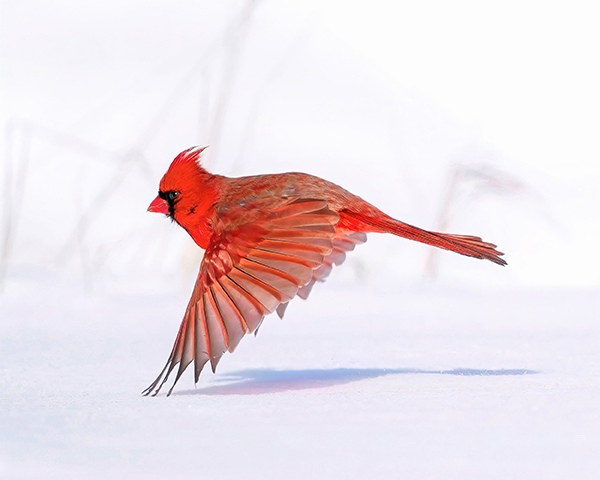
Q: Please share with us the story behind this winning (2021 Audubon Photography Award) image of a Northern Cardinal.
A: On this day I traveled an hour from my home to a municipal wastewater facility that eagles and snowy owls frequent in the winter near Muskegon. It was a bitterly cold day, but a rare sunny one in winter Michigan. When I arrived at the facility many of the roads were not plowed and impassable because of deep snow. The lakes were frozen and most of the ducks, eagles, and owls were nowhere to be found.
Not being in an area I could hike; I circled the facility in my vehicle on rural side roads. I like how a vehicle acts as a blind and how most wildlife will let you approach at a reasonable distance if one moves slowly enough.
As I made my way down one of the roads, I noticed a hawk atop a pine tree about a quarter-mile ahead of me. I slowly approached in my vehicle and as I got within 100 yards or so the hawk flew right to left in front of me. I pulled to the side of the road and shot through my driver’s side window. Unfortunately, all I could see was its tail end.
Disappointed in having failed that shot, I looked right and through the passenger window, I noticed the much smaller male northern cardinal. It was flying close to the ground from dead weed to weed and feeding on the seeds. I was taken by the bright red against the pure white snow and the detail and saturation as it was front-lit by the afternoon sun. I found this a bit unusual as most cardinals I’d seen are higher in trees and at feeders.
I rolled down the passenger and driver side windows, shut off the engine and the heat, and leaned my upper body as far out the window as I could. I proceeded to start up and move my car forward to follow the cardinal two or three times and photograph in between. My hope was to get the cardinal in flight as it moved between weeds.
I left the heat off and the windows open so the car would cool down quickly. I’d had problems in the past with the warm air escaping the windows into the cool and giving me unsharp, heatwave effect images.
I had the camera set to high speed for the drive and a high shutter speed of 1/5000th of a second. For this shot, I shot two frames. This was the first shot as I reacted when he took flight from the weed. In the second frame, he was gone. I was fortunate on this try that the cardinal flew straight which was perfectly perpendicular to me. Many of the other tries it flew angled a bit to his right or left which ruined the shot. I cropped the weed out which was in the frame to the right.
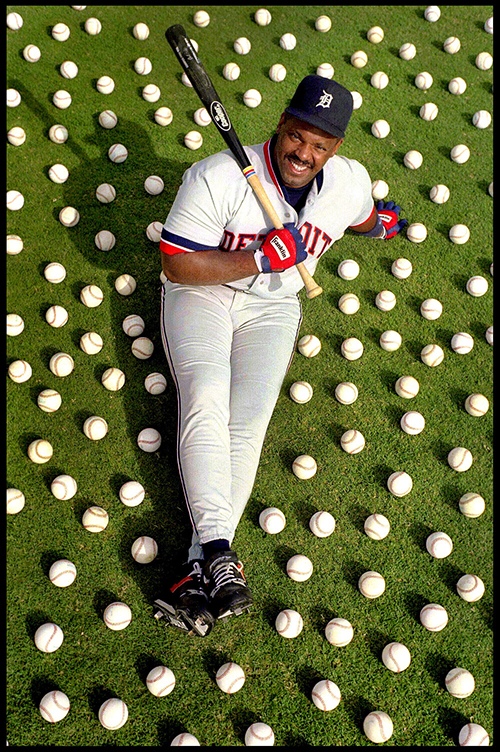
Q: You also take images of people’s portraits. Please share with us some of your memorable experiences when taking those shots.
A: I prefer to make images of people, like birds – doing things. As a photojournalist, we couldn’t ask people to do things for us to take pictures of. We try to capture life as it is – not as we create. If we posed portraits, we made sure it was obvious they were posed.
I remember photographing Cecil Fielder of the Detroit Tigers baseball team. He was the RBI champion for three consecutive years, and I was assigned to make a portrait of him at spring training in Lakeland, Florida. Much of the success of a posed portrait is planning and concept. I imagined a shot from above of Fielder sitting on the ground, laying back surrounded by baseballs. I thought this would be striking and graphic and would make a great cover for the season preview.
I approached the Detroit Tigers marketing contact and was given a 15-minute window before a future morning practice at 10 am to make the shot. I arrived at the field at 8 am that day and scrounged up every baseball I could find and a ladder and proceeded to the outfield to set the shot up so I’d be ready when Fielder arrived. I arranged the balls with the logo down in a 6’ x 10’ area of grass. I paid attention to the spacing of the balls and the direction of the light. I was ready and waited for Fielder to arrive.
As the time approached, I saw Fielder chatting with other players. 9:45 arrived and he still hadn’t made his way out. 9:50 no Fielder. Finally, he started wandering out towards me. 9:55 he arrived.
He got out there, saw my set up, and said, “You want me to sit there? No way am I doing that.” I explained how cool this was going to look and it was going to make a great cover pic highlighting him. I’d get to the top of the ladder and shoot down as he looked up. He told me to sit there, give him my camera and let him climb up and see. He climbed to the top of the ladder with his cleats on and looked through my camera and said, “This is cool! You want me there?!?” We exchanged positions, I made less than a roll of film and had just a couple of minutes for the shot. The final image is on my website in the portrait section at www.stevejessmore.com
My favorite portrait series I’ve done was called “Sense of Community” in Flint, MI.
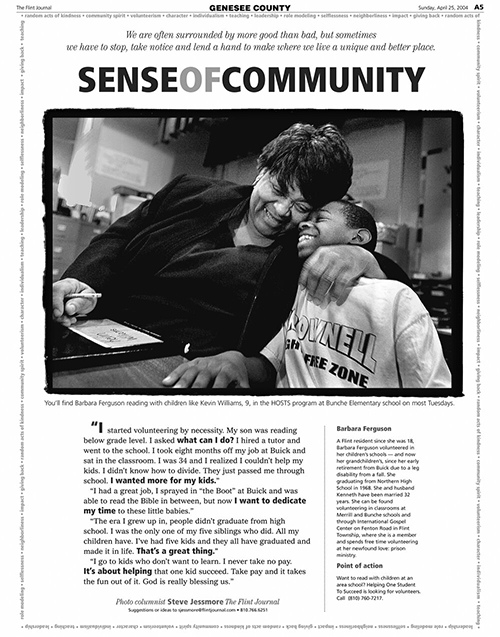
Q: You have participated in a project called “Sense of Community”. Please tell us about this project and how you came away from the project.
A: The idea for “Sense of Community” came during my job interview at The Flint Journal in 1999. As I arrived in the boardroom with editors and reporters, we made our greetings, and then I sat down at the table across from the editor of the newspaper.
The first question he asked me, paraphrased the best I can remember, was: “Why in the hell would you come to Flint? We lead the country in murders, rapes, robberies. You can go anywhere, why would you come to this god-forsaken place?”
This caught me by surprise. I was a photo editor and was working in my hometown Saginaw and I needed a professional change. Flint was nearby and I wouldn’t have to move my family. It was the same company so I wouldn’t lose seniority. I proceeded to tell him that they were going to let me take pictures again and that was important to me after a few years of editing.
Then it hit me. I remember saying, “And also that all may be true about Flint, but I bet you that even with all the bad there are probably 93% good people here instead of 94% somewhere else. It’s really how you look at it. There are a lot of good stories to be told.” At that moment I knew I had an idea I would explore.
I started working there and getting to know the community. That exchange always stuck in the back of my head as I worked. I began refining the idea with my photo editor to do a photo column once a week. We came up with the concept, pitched it, and were given Page 5 of the A section every Sunday to do my column. This was premium space.
Each week the column featured a photo I made of someone doing what they do to make Flint a better place. I used verbatim text to have them tell why they did what they did and why they had hope for Flint. There was a point of action with contact information for others to join in if they were inspired to do so. The column ran 175 times between 2004-2008. I was given one day a week to find, write and photograph, design, and produce the column. These days were usually at least 14-hours each. The columns are all posted on my website.
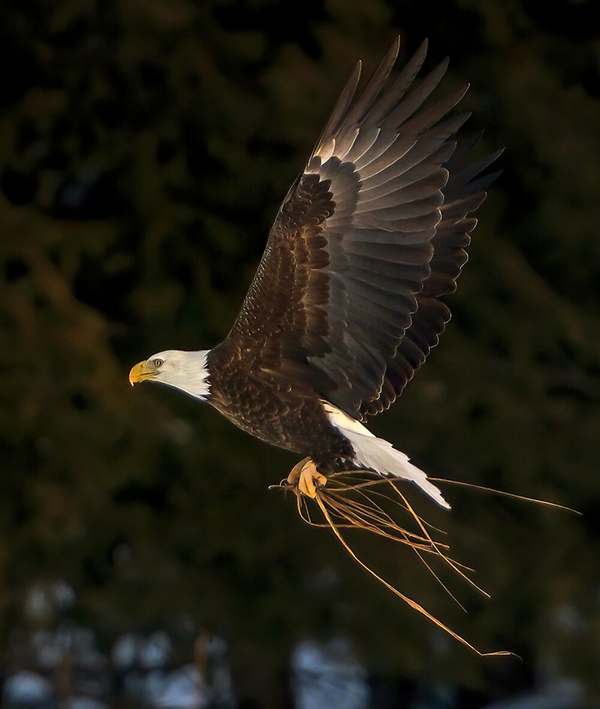
Q: What do you look for when taking images of wildlife, especially birds: the composition, movement of light, something else?
A: My favorite times to shoot wildlife are dawn and dusk. Our cottage faces east so the sun rises in my face and sets behind me as I sit on the shore of the Torch River. My favorite birds are mostly waterfowl- ducks, geese, raptors, loons, and swans. I love how they use this river and its marshes as their home.
While I’d attempted to photograph wildlife occasionally most of my life, I never had the time or support to do so. Family and work were the priorities, vying for my attention and time. What I wanted didn’t really enter into the equation. Now that my kids are grown and I freelance, during covid, I realized that this is a passion and it’s OK that I do something that I enjoy too. My wife Brenda is supportive of me being creative and I’m blessed. I am now obsessed with “birds doing things”.

I love composing on the fly. I always captured moments as a photojournalist. As I learn bird behavior, I now try to incorporate moments within the composition. Light is very important to me, and I rarely shoot during the mid-day hours when the sun is high. I like weather elements like rain and snow too. This adds another dimension.
I like to look for the interaction of birds with other birds or prey. The circle of life is what it’s all about. Birds and other animals are trying to survive and find their next meal much of the time. I like showing that narrative. I love to use my kayak to integrate myself into their space.
These are some of the things that I hope make my photography unique.
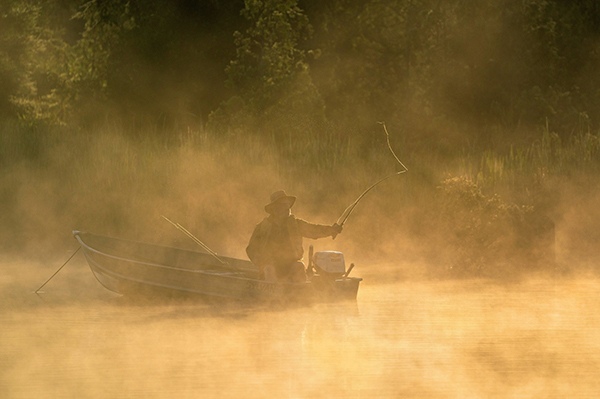
Q: What is your philosophy regarding photography?
A: I enjoy the challenge of making great images in everyday situations. I learned early in journalism every subject deserves the same effort and respect. It didn’t matter if I was assigned to the world series or to a community fundraiser. I needed to come back with images that told stories and filled pages. You couldn’t come back empty-handed.
Photography has always been the way I’ve made my living. It’s what I do. Cameras, lenses, and lights are my tools. I pick up a camera and I am working. I need to be at one with the equipment so it’s second nature and I can see and create.
I am thankful for the gift of time and perspective Covid gave to me. I rarely made pictures for fun. The “birds doing things” project started as a covid learning challenge. It was something that had to be solved technically, logistically, and creatively. I posted pictures to social media, and they made people happy during a tough time. People were isolated in their homes, and they told me I was giving them a window to the world. I received numerous notes from other photographers thanking me for inspiring them to get out and take pictures too. That was all the reward I needed.
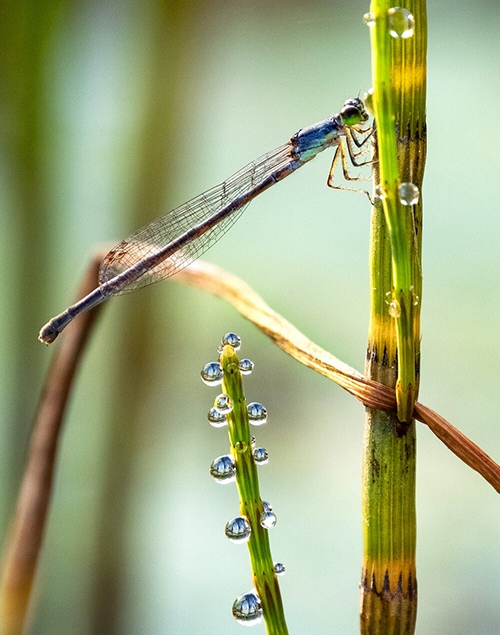
Q: If you were to give advice to aspiring photographers, what would it be?
A: Patience and work ethic will take you far. Too many get frustrated or settle for the quick, easy image. It was hard for me to break out creatively and start personal work. It took covid and 45-years of experience.
I also realized early I needed to be my toughest critic. It’s great that your friends or family tell you how good you are, but you really need to learn to be constructive and tough on yourself at the same time. Be honest. Is this really the best you can do? What could you have done better? What will you do next time?
I’ve always found it easier to spend countless hours photographing things that I’m passionate about. I never thought about monetizing or awards for my bird photography. It was the challenge of learning something new that I loved.
Be realistic about the business side if that’s where you are heading. Technology has made basic image capturing easier than ever before. There’s no need for a darkroom or even computers. You need to really find a way to separate yourself from the competition and figure out where you want to head. Will it be for fun or for-profit? Find your niche.
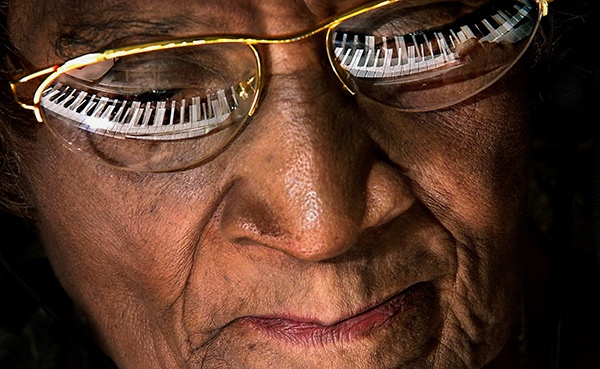
Q: Does any artist or literature inspire you with regards to your photography?
A: My biggest visual influence has been W. Eugene Smith. I love the way he told stories and the respect he had for his subjects. His lighting, transitions, and drama within the frame are spectacular. I also have loved the work of Jack Leigh who is now deceased from Savannah. His work is timeless and quiet. Some other photographers I enjoy I have close ties to. Justin Cook, Scott Brauer, and Sarah Rice were former interns and I’m in love with their work and vision. Sarah worked in the San Francisco area for a time. All worked with me in Flint.
The literature of Pat Conroy is my favorite. I’ve done a lot of photography in the low country and Charleston and Savannah which are my favorite spots to visit. I love “South of Broad”. “The Water is Wide” is a close second.
Much of my sanity comes from music. I like storytellers and hard rock – music I can get lost in and not think about but absorb the creativity and energy. Jack White, Sleater-Kinney, and Morphine are among my favorite artists. During my career, I’ve also loved to let an opera play in the background as I edit.
I tend not to look at a lot of nature images by other photographers. I like to see where my creativity will take me and trust my vision.
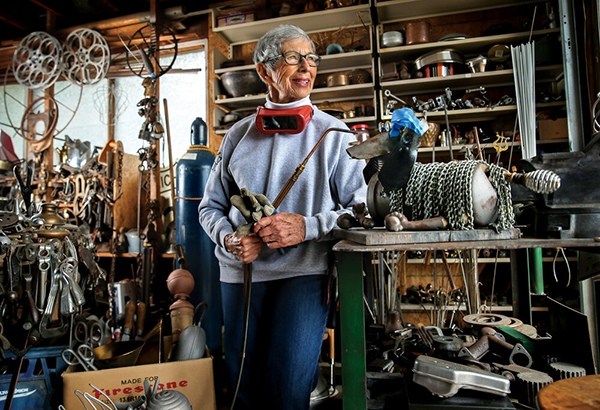
Q: Do you have any future projects that you would like to share with our readers?
A: Sweeping the professional category of the Audubon Photography contest has definitely given me momentum to continue pursuing my bird and wildlife photography. I am in the process of working on my website and populating a newly added sales section with my favorite images.
I am still working full-time freelancing. My work has returned, but I’ve committed to spending at least one day a week with this new love.
I have done a lot of shooting this last year and very little serious editing. I hope to dedicate some to dig deep into my nature images and see what I have. One set of images I’ve done focuses on ironwork in Charleston and Savannah. I am also working on a project on the Torch River and more importantly what it means to me. Most of my nature photography is done within a square half-mile. I enjoy making images close to home and believe you don’t have to have a high profile, unusual, or far away subjects to make great photography.
I’m currently editing images and writing a book about my experience this last year, what I learned and my covid project. I still find the experience surreal going from challenging myself to learn something new to winning this award. I hope to find a publisher.
I continue to post multiple times a week to my Instagram @sjessmo. I also post to my Facebook page. I’d love to have you follow me and let me know what you think.
